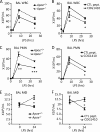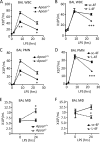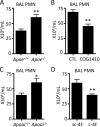Apolipoproteins and apolipoprotein mimetic peptides modulate phagocyte trafficking through chemotactic activity
- PMID: 23118226
- PMCID: PMC3527958
- DOI: 10.1074/jbc.M112.377192
Apolipoproteins and apolipoprotein mimetic peptides modulate phagocyte trafficking through chemotactic activity
Abstract
The plasma lipoprotein-associated apolipoproteins (apo) A-I and apoE have well described anti-inflammatory actions in the cardiovascular system, and mimetic peptides that retain these properties have been designed as therapeutics. The anti-inflammatory mechanisms of apolipoprotein mimetics, however, are incompletely defined. Whether circulating apolipoproteins and their mimetics regulate innate immune responses at mucosal surfaces, sites where transvascular emigration of leukocytes is required during inflammation, remains unclear. Herein, we report that Apoai(-/-) and Apoe(-/-) mice display enhanced recruitment of neutrophils to the airspace in response to both inhaled lipopolysaccharide and direct airway inoculation with CXCL1. Conversely, treatment with apoA-I (L-4F) or apoE (COG1410) mimetic peptides reduces airway neutrophilia. We identify suppression of CXCR2-directed chemotaxis as a mechanism underlying the apolipoprotein effect. Pursuing the possibility that L-4F might suppress chemotaxis through heterologous desensitization, we confirmed that L-4F itself induces chemotaxis of human PMNs and monocytes. L-4F, however, fails to induce a calcium flux. Further exploring structure-function relationships, we studied the alternate apoA-I mimetic L-37pA, a bihelical analog of L-4F with two Leu-Phe substitutions. We find that L-37pA induces calcium and chemotaxis through formyl peptide receptor (FPR)2/ALX, whereas its D-stereoisomer (i.e. D-37pA) blocks L-37pA signaling and induces chemotaxis but not calcium flux through an unidentified receptor. Taken together, apolipoprotein mimetic peptides are novel chemotactic agents that possess complex structure-activity relationships to multiple receptors, displaying anti-inflammatory efficacy against innate immune responses in the airway.
Figures







Similar articles
-
A subset of five human mitochondrial formyl peptides mimics bacterial peptides and functionally deactivates human neutrophils.J Trauma Acute Care Surg. 2018 Nov;85(5):936-943. doi: 10.1097/TA.0000000000001971. J Trauma Acute Care Surg. 2018. PMID: 29787548
-
Calpain inhibitors stimulate phagocyte functions via activation of human formyl peptide receptors.Arch Biochem Biophys. 2011 Sep 1;513(1):51-60. doi: 10.1016/j.abb.2011.06.007. Epub 2011 Jun 23. Arch Biochem Biophys. 2011. PMID: 21723247
-
Comparison of anti-endotoxin activity of apoE and apoA mimetic derivatives of a model amphipathic peptide 18A.Innate Immun. 2014 Nov;20(8):867-80. doi: 10.1177/1753425913514621. Epub 2013 Dec 9. Innate Immun. 2014. PMID: 24323453
-
Basic characteristics of the neutrophil receptors that recognize formylated peptides, a danger-associated molecular pattern generated by bacteria and mitochondria.Biochem Pharmacol. 2016 Aug 15;114:22-39. doi: 10.1016/j.bcp.2016.04.014. Epub 2016 Apr 27. Biochem Pharmacol. 2016. PMID: 27131862 Review.
-
Potential clinical utility of high-density lipoprotein-mimetic peptides.Curr Opin Lipidol. 2006 Aug;17(4):440-4. doi: 10.1097/01.mol.0000236371.27508.d4. Curr Opin Lipidol. 2006. PMID: 16832169 Review.
Cited by
-
Melatonin Suppresses Macrophage M1 Polarization and ROS-Mediated Pyroptosis via Activating ApoE/LDLR Pathway in Influenza A-Induced Acute Lung Injury.Oxid Med Cell Longev. 2022 Nov 15;2022:2520348. doi: 10.1155/2022/2520348. eCollection 2022. Oxid Med Cell Longev. 2022. PMID: 36425057 Free PMC article.
-
The 5A apolipoprotein A-I (apoA-I) mimetic peptide ameliorates experimental colitis by regulating monocyte infiltration.Br J Pharmacol. 2016 Sep;173(18):2780-92. doi: 10.1111/bph.13556. Epub 2016 Aug 11. Br J Pharmacol. 2016. PMID: 27425846 Free PMC article.
-
Emerging Roles of Apolipoprotein E and Apolipoprotein A-I in the Pathogenesis and Treatment of Lung Disease.Am J Respir Cell Mol Biol. 2016 Aug;55(2):159-69. doi: 10.1165/rcmb.2016-0060TR. Am J Respir Cell Mol Biol. 2016. PMID: 27073971 Free PMC article. Review.
-
Apolipoprotein A-I mimetics.Curr Opin Lipidol. 2014 Aug;25(4):304-8. doi: 10.1097/MOL.0000000000000092. Curr Opin Lipidol. 2014. PMID: 24977978 Free PMC article. Review.
-
A New Frontier in Immunometabolism. Cholesterol in Lung Health and Disease.Ann Am Thorac Soc. 2017 Nov;14(Supplement_5):S399-S405. doi: 10.1513/AnnalsATS.201702-136AW. Ann Am Thorac Soc. 2017. PMID: 29161079 Free PMC article. Review.
References
-
- Murphy A. J., Woollard K. J. (2010) High-density lipoprotein. A potent inhibitor of inflammation. Clin. Exp. Pharmacol. Physiol. 37, 710–718 - PubMed
Publication types
MeSH terms
Substances
Grants and funding
LinkOut - more resources
Full Text Sources
Molecular Biology Databases
Miscellaneous

